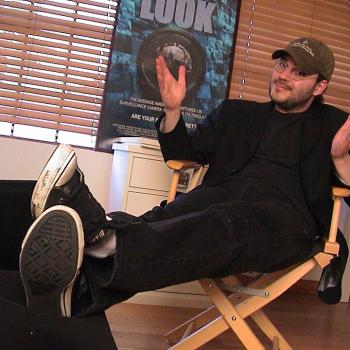
Source: Wikimedia
Tammy and the T-Rex (1994) is a B-movie done well and under immense pressure. Maybe necessity is the mother of innovation. I don’t know. Ask Roger Corman. What I do know is that ingenuity deserves praise, as does a willingness to (and this seems impossible now, doesn’t it?) have a little fun. My day job is as a medievalist. And for all the supposed religious dourness of the so-called “Dark Ages,” they loved a good laugh (and a good fart joke for that matter). This Stewart Raffill-directed effort delivers on the ha-ha (if not the flatulence).
The plot is thinner than a medieval serf’s gruel before the invention of three-field crop rotation. Tammy (Denise Richards) has a boyfriend named Michael (Paul Walker). Billy (George Pilgrim), her ex, is possessive and doesn’t want her seeing a new dude. This comes to a head when Michael is caught sneaking into Tammy’s room (up a trellis of course); Billy is none too happy and viciously beats the new guy, leaving him for dead in some sort of animal preserve (where there’s a live lion?). Michael dies. But fear not: a mad scientist, Dr. Gunther Wachenstein (Terry Kiser) implants the dead boy’s brain in a giant animatronic T-Rex. Reptilo-Michael, now conscious once more, kills his way back to his one true love. Heartwarming.
What makes the movie remarkable is the story of its production. Raffill has said that he was approached by a South American theater owner who happened to have such an animatronic (one assumes the popularity of 1993’s Jurassic Park didn’t hurt either). He had no script, but asked Raffill if he wanted to make a movie with it while he still had it (he was due to ship it away not long in the future). And so, Raffill cobbled something together. Tammy and the T-Rex is the result.
The speed of the process allowed the writer-director to be silly. You can only do so much with a few weeks, no script, and a gigantic fake dinosaur. We end up with wonderful sequences like Michael qua T-Rex dialing a pay phone with his “hands” (clearly just human hands in green gloves). The camerawork emphasizes the absurdity of his appendages, at one point giving us a near close-up of Michael the Mega-Predatory crying over his lost love. Tammy’s best friend is the fabulously gay Black son of the sheriff, whose outfit choices exist somewhere between those of Hooper-X in Chasing Amy (1997) and Lulu in Something Wild (1986). He plays a part-monk, part-Garveyite who constantly stands up for Tammy against her abusive ex. His name: Byron Black (Theo Forsett). Not exactly the most creative joke, but the movie makes him such a ridiculous hero you don’t much care. He works.
The 2019 re-release (the one I watched) includes 6 additional minutes, all of which were cut from the original to ensure a PG-13 rating. The highlight of these is a horrifically bloody brain transplant scene in which the good doctor slices open Michael’s head, pulls out one of those great 80s body horror brains, and plops it into his dinosaur. Pure B-movie art. And the sort of thing that, in my case anyway, makes me wonder why we don’t see more practical effects in movies today (it’s money, I know. But let me pretend; let me dream).
If that doesn’t sound like it’s for you, that’s fine. It probably isn’t. But to me it’s a celebration of the elasticity of cinema, just how far you can push the medium—even if it’s just in the direction of silliness. Any movie that ends with Denise Richards beginning a striptease for her boyfriend who is now an alcoholic brain-in-a-vat hooked up to a primitive webcam—that’s got the sauce. To put that together in a couple months: that’s the beauty of the human mind as expressed in cinema.












